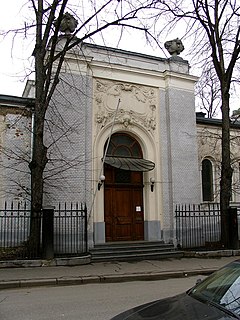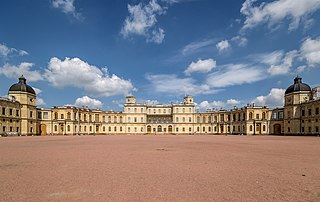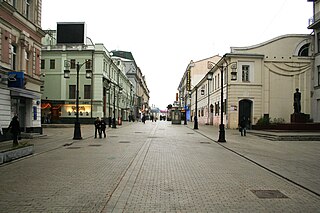
Chekhov Library in Taganrog is the oldest library in the South of Russia.

The Russian Revival style is the generic term for a number of different movements within Russian architecture that arose in the second quarter of the 19th century and was an eclectic melding of Byzantine elements and pre-Petrine architecture.

Ivan Aleksandrovich Fomin was a Russian architect and educator. He began his career in 1899 in Moscow, working in the Art Nouveau style. After relocating to Saint Petersburg in 1905, he became an established master of the Neoclassical Revival movement. Following the Russian Revolution of 1917 Fomin developed a Soviet adaptation of Neoclassicism and became one of the key contributors to an early phase of Stalinist architecture known as postconstructivism.

Fyodor Osipovich Schechtel was a Russian architect, graphic artist and stage designer, the most influential and prolific master of Russian Art Nouveau and late Russian Revival architecture.

William WalcotRE was a Scottish architect, graphic artist and etcher, notable as a practitioner of refined Art Nouveau in Moscow, Russia. His trademark Lady's Head keystone ornament became the easily recognisable symbol of Russian Style Moderne. In 1920s–1930s, he concentrated on graphic art and was praised as "the best architectural draftsman" in London.

The Great Gatchina Palace is a palace in Gatchina, Leningrad Oblast, Russia. It was built from 1766 to 1781 by Antonio Rinaldi for Count Grigori Grigoryevich Orlov, who was a favourite of Catherine the Great, in Gatchina, a suburb of the royal capital Saint Petersburg. The Gatchina Palace combines classical architecture and themes of a medieval castle with ornate interiors typical of Russian classicism, located on a hill in central Gatchina next to Lake Serebryany. The Gatchina Palace became one of the favourite residences of the Russian Imperial Family, and during the 19th century was an important site of Russian politics. Since the February Revolution in 1917 it has been a museum and public park, and received UNESCO World Heritage Site status in 1990.

Alexander I Palace in Taganrog is a one-story stone building in Russian classicism style on Grecheskaya Street, 40 where Russian emperor Alexander I died in 1825.

The Governor's Mansion, also known as Kuklin House is a building in Tobolsk, Russia. It was the home of the governor of Siberia prior to the February Revolution of 1917. The house, which is located on 10, Mira Street in the area of Tobolsk below the Kremlin (Podgora), is protected by Russian Federal government as a historical monument.

Odesa Fine Arts Museum is one of the principal art galleries of the city of Odesa. Founded in 1899, it occupies the Potocki Palace, itself a monument of early 19th century architecture. The museum now houses more than 10 thousand pieces of art, including paintings by some of the best-known Russian and Ukrainian artists of late 19th and early 20th century. It is the only museum in Odessa that has free entrance day every last Sunday of the month.

The Museum of history of Don Cossacks is a museum of art, culture and history of Don Cossacks in Novocherkassk, Rostov oblast, Russia. The oldest museum in Southern Russia, it was founded in 1886. Its collections, of which only 151,000 items is on permanent display, comprise over 200,000 items. The collections occupy a complex of four historic buildings in Novocherkassk: the main building on Atamanskaya street, Memorial House-Museum of painter Ivan Krylov, Memorial House-Museum of painter Mitrofan Grekov and the Ataman palace.

The House-Museum of Ivan Krylov opened in 1979 in Novocherkassk, Rostov oblast, Russia and is devoted to the exhibition of the Russian and Soviet theatre painter's pieces of art, as well as to the research and study of Cossacks households. It is an affiliate of the Museum of Don Cossacks. An historic building of the museum is considered to be an object of cultural heritage.

Hotel Raftopulo is a cultural heritage of regional significance. The hotel located along October Street, 35 in Taganrog, Rostov Region. Since 1992 it belongs to the monuments of the city history.

The Gayrabetov Mansion is a building in Rostov-on-Don, located on Liberty Square. The house was built in 1880. Initially it belonged to the relatives of merchant Karp Gayrabetov. At the beginning of the 20th century, the building was acquired by the manufacturer Mark Iskidarov. Since 2011, the Museum of Russian-Armenian Friendship has been located in the mansion. The Gayrabetov Mansion has the status of an object of cultural heritage of regional significance.

The House of Deminoj-Cachoni is an object of cultural heritage of regional value which settles down the street Greek, 47 in the city of Taganrog of the Rostov Oblast. The structure received the name on the surnames of two most famous owners – Margarita Cachoni and Aleksandra Dyomina.

The House of Drevitsky is an ancient mansion in Taganrog, a monument of architecture of the 1840s. Treated architecture monuments, is among objects of cultural heritage of the Russian Federation under a code No.6101267000.

The House of Nomikos is an object of cultural heritage of regional value of the second half of the 19th century in the city of Taganrog of the Rostov Oblast. It is located at the address Grecheskaya Street, 53. Treats historical and cultural monuments.

Art Nouveau is an international style of art, architecture and applied arts, especially the decorative arts, that was most popular between 1893 and 1910. In the Russian language it is called Art Nouveau or Modern.

The Fontanka Embankment is a street in Saint Petersburg that follows the course of the Fontanka River from its origin as it diverges from the Neva River up to its confluence with the Great Neva. In 1762–1769 the general plan of city development was developed by the State Special Committee, headed by Aleksei Kvasov. Following this plan, in the 1780s the shores were imbanked in granite by architect Giacomo Quarenghi. The Fontanka Embankment was used as a border of Saint Petersburg central part.

Kamergerskiy Pereulok or Chamberlain Lane is a short street with many historical buildings located within the Boulevard Ring in central Moscow.


























